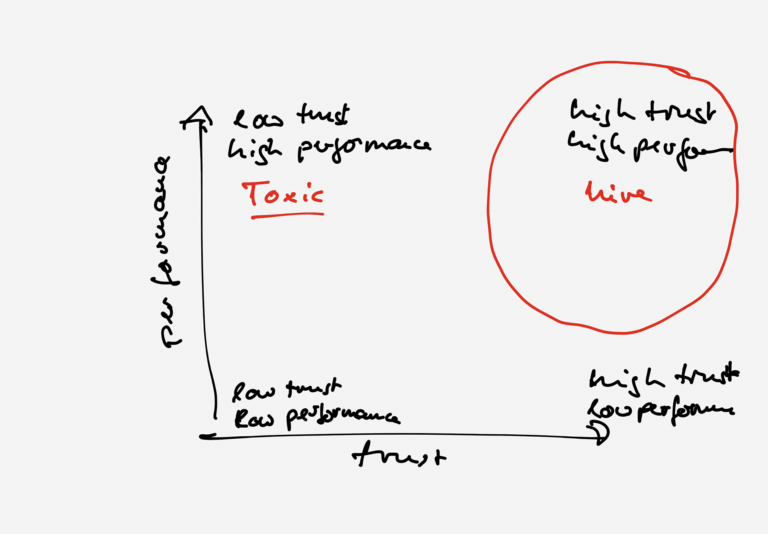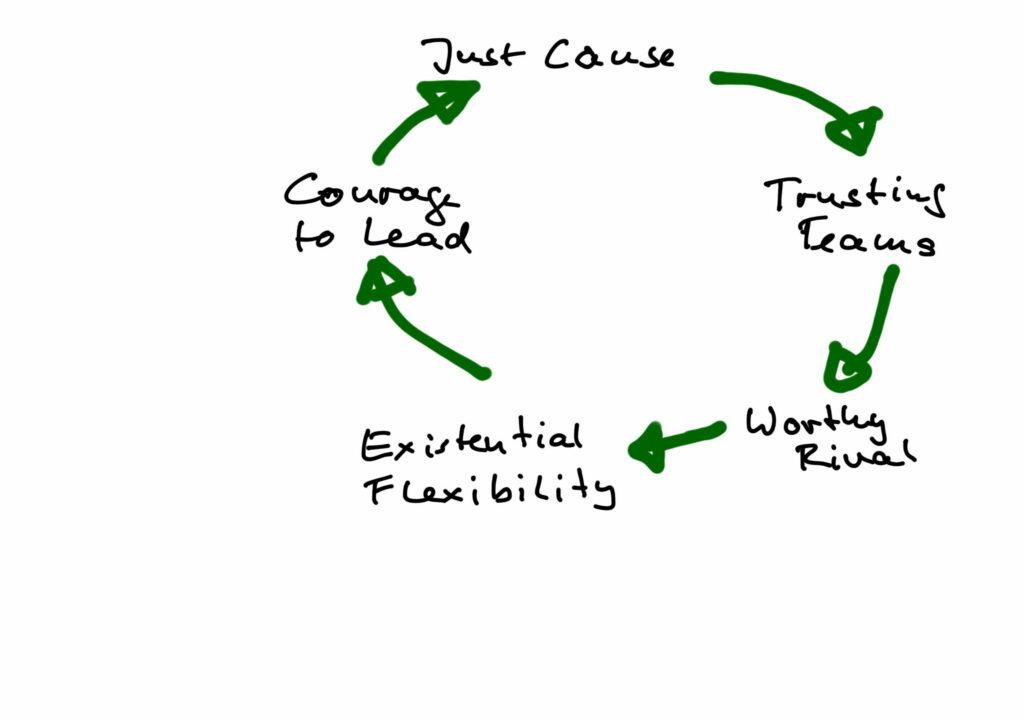In the last six months, I’ve come across Infinite Games and a few other books, each of which are very interesting on their own, but which, taken together, have provided me with some new insights into agile as a whole. I actively use the concepts in my management seminars.
I want to share those and this is the third blog in this series. The first on Humanocracy can be found here the second on “Good to Great” is here.
There are at least two types of games. One could be called finite, the other infinite. A finite game is played with the goal of winning, an infinite game with the goal of continuing.
– Carse, James. Finite and Infinite Games (p.3). Free Press 1986. Kindle version.
In his book “Infinite Games”, Simon Sinek starts an unusual journey with what at first seems to be a very theoretical picture from game theory. I initially felt the need to nod while reading: yes, exactly, I thought so too. But then he gets to a point where I was satisfied with the result and comes to further, very profound realizations. Thus, from game theory, he arrives at a description of the current business landscape (from his perspective, of course, first that of the U.S.) and then at results that have a direct impact on concepts of management and leadership.
Winners and losers
We have become accustomed to seeing the world in terms of winners and losers. This strategy, for which we use the metaphor “finite games,” usually has serious long-term consequences for the way a company operates.
- Finite games are played by well-known players. They have fixed rules. And there is an agreed upon goal that, when reached, ends the game. Many of these games are “zero-sum” games.
- Infinite games have infinite time horizons. And because there is no finish line, no practical end to the game, there is no such thing as “winning” in an infinite game. In an infinite game, the primary goal is to keep playing, to keep the game going.
When we participate in an infinite game with a finite mindset, we miss an essential aspect of the game. We use arbitrary, often irrelevant metrics (like “the best”, “number 1 in sales”) that are not essential to long-term survival.
But more seriously, this approach affects the way we cooperate, the image we have of collaborators, triggering unintended consequences such as loss of trust, cooperation and innovation.
For businesses (if you ignore startups, which are not really businesses yet, but rather experiments that can lead to the creation of a business), their business environment is the literal definition of an endless game.
Simon Sinek vividly introduces this distinction with an example of two product presentations (in this case, Zune and iPod) by Microsoft and Apple;
- At the Microsoft event, the majority of the speakers devoted a good portion of their presentations to how they would beat Apple.
- At the Apple event, 100 percent of the presenters spent 100 percent of their time talking about how Apple is trying to help teachers teach and students learn.
Microsoft had chosen a metric (“beat Apple in music players”), but it didn’t offer them any help on how to proceed with the next product. And just as “after the game is before the game”, the same applies: after every product comes the next. Only a consistent perspective provides the continuous long-term orientation.
Apple had this north star, this end-to-end orientation: to create the best user experience for its customers. And that gave them advantage, gave them resilience to perform properly under changing demands.
But Sinek goes deeper: he elaborates on specific practices that a leader must incorporate if he or she is to develop a company that succeeds under these conditions:
- Advancing a just cause
- Building trusting teams
- Worthy competitors study
- Prepare for existential flexibility
- Demonstrate the courage to lead
The just cause
A just cause is another developed idea of Start with Why. But: it is not the same as the WHY. A WHY comes from the past. It is an origin story. It is a statement of who we are – the sum of our values and beliefs. A just cause is about the future.
A just cause must be:
- for something – affirmative and optimistic -.
- inclusive – open to all who wish to contribute –
- service-oriented – for the primary benefit of others – thereby building a loyal base of employees and customers (and investors) who will remain loyal to the company through thick and thin.
- resilient – can withstand political, technological and cultural changes -.
- idealistic – big, bold and ultimately unattainable – attainable is a vision that also plays an important role.
What doesn’t qualify as a good thing is
- Moon shots, i.e. targets that are difficult to reach
- “to be the best”, i.e. to measure oneself against the competition
- Growth per se
- Social responsibility, i.e. things that the company also pursues in addition to its actual objective
The role of leadership
From this point of view, perhaps the role of a CEO should be redefined as “guardian over the good cause” or “chief vision officer”.
Martin Luther King Jr. Says in his legendary speech “I have a dream” – he did not say “I have a plan”. Of course he needed a plan, but as the “CEO” of the civil rights movement, he was not responsible for making the plan. He was responsible for the dream and for making sure that those who were responsible for the plans were working to move the dream forward. His responsibility was to look beyond the day and keep the dream alive.
Sinek identifies three pillars of an organization – advancing a purpose, protecting people and generating a profit. “Inifinite Game” minded leaders work hard to get these priorities right; to look beyond the financial constraints of the current day and they put people before profits as often as possible. This promotes employee engagement and prepares the following point: trusting teams.
Trustworthy teams
Leaders are not responsible for results, leaders are responsible for the people who are responsible for the results. And the best way to drive performance in an organization is to create an environment where information can flow freely, mistakes can be pointed out, and help can be offered and accepted.
In short, an environment where people feel safe among themselves.
Many organizations view the ability to work together in a team in a trusting manner as tending to be more important than pure performance, even saying that narcissistic high achievers can have a toxic effect on teams.

If all the metrics that say who is ahead and who is behind are arbitrary and change over time – what can I use to get a score. Also, in an infinite game, there is no finish line, so you are trying to compete in an unwinnable race.
However, I can take my cue from a competitor who is doing a good job. The truth is, although we do similar things, he is not my competitor (in the finite game sense), he is my rival (on the same path as me). My very worthy rival, though we benefit from each other just as much by generating new ideas in competition.
Worthy rivals help us to become better, they help us to stay grounded, that is, to remain honest and ambitious.
Existential flexibility
Flexibility also takes on a different undertone when viewed in the light of an infinite game: it becomes broader than the range of tactical measures that become appropriate to achieve the current business goal – flexibility in the long run challenges all fixed points, becomes existential. What this kind of flexibility means can be illustrated by the example of Kodak: Kodak was founded with the purpose of making photography as easy and accessible as possible for everyone – a very good example of an infinite mindset.
Over time, another generation of finite-minded leaders came to the helm. When digital photography emerged, Kodak did have the vast majority of patents. But they did not use them to reinvent themselves. Instead, they decided to suppress the new technology as long as possible to stave off the inevitable and continue selling silver-based films until then.
The effect is all too familiar: When Kodak’s patents expired in 2007, the money dried up, and five years later Kodak filed for bankruptcy.
Existential flexibility is the ability to initiate extreme disruption of a business model or strategic course to more effectively advance a just cause, even if it disrupts the existing business model.
Kodak has failed in this challenge. In this respect, disruptions are sometimes the direct effect of a finite mindset.
The courage to lead
How do we find the courage to change our way of thinking?
We can wait for a life-changing experience that shakes us to our foundations and challenges the way we see the world.
Or we can find a righteous cause that inspires us; surround ourselves with others with whom we share a common cause, people we trust and who trust us; identify a rival worth comparing that spurs us to keep improving; and remind ourselves that we are more committed to the cause than to any particular path or strategy we happen to be pursuing.
The environment doesn’t make it any easier: Wall Street analysts (or their local equivalent) tend to write for the short-term community. Therefore, it does not take courage to maintain a finite mindset






